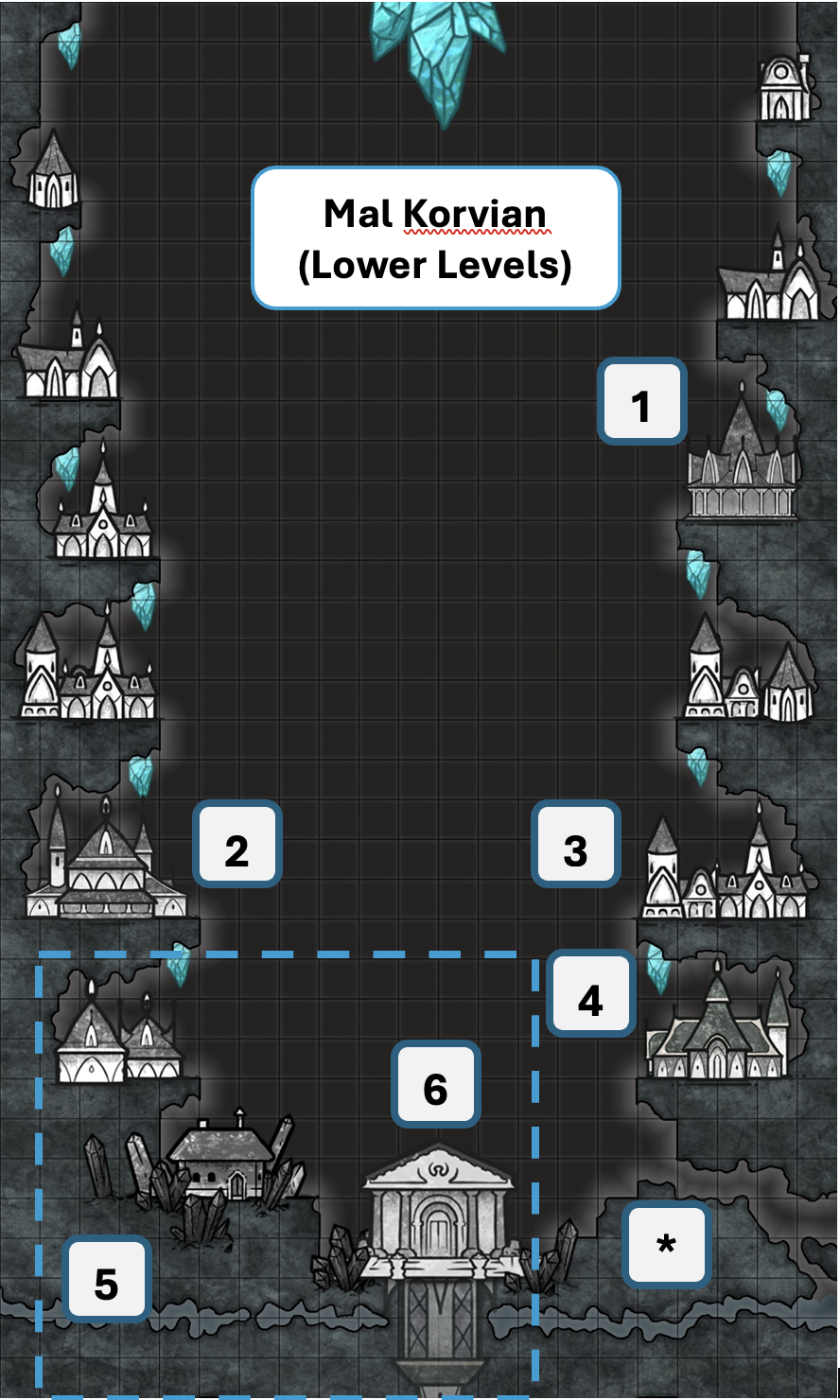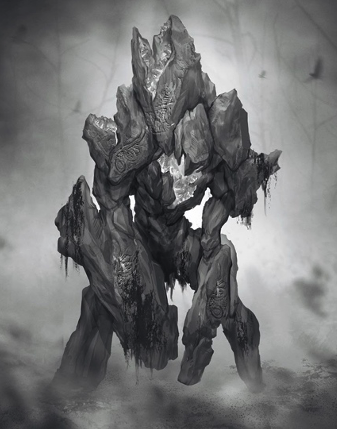Mal Korvian
All of the Earthen Drow cities are multi-leveled subterranean wonders, but Mal Korvian is the grandest and most opulent of them all. Per its name, Mal Korvian was once ruled by the Mal Korvian royal family. After the family’s eradication, the remaining 3 royal families secured joint control of the city, rebranding it as the capital of the Stonelands. The vertically sprawling city was built around an underground river and the Temple of Malachor, which marked the city’s lowest level. As Mal Korvian was founded in the era of isolation from the surface for the Earthen Drow, the original city was never exposed to sunlight. Although the Earthen Drow are well adapted to the darkness, the many levels of their city were adorned with faintly bioluminescent subterranean flora and luminescent crystals. Even after the city was opened to the surface, sunlight only ever reached the 5 upper levels of the city.
The lower levels of Mal Korvian connected directly to a sprawling, maze-like series of caverns and underground tunnels that were overflowing with various resources, including the largest “vein” of obsidian. In their years underground, the Earthen Drow learned to create, bind, and control Earth Elementals, modifying them to suit specific purposes: mining, building, hauling materials, defense or other combat, and more. With the wealth that Mal Korvian amassed from its own resources and the wealthy of the other royal families, enough Earth Elementals were been created and bound to conduct all labor in the caverns below.
The worship of Malachor, the Death Scribe, was the dominant religion in Mal Korvian. The local Earthen Drow believed that the deeper one descended, the closer one was to Malachor and his influence. Those outside the Stonelands believed that the Earthen Drow – in their many centuries sequestered underground – had learned to influence the will of death itself and could, if they so chose, tip the scales of those who lived and those who died. While the Drow did not hold any broad-sweeping power over death, the Earthen Drow did believe that their adjacency to the Gates of Malachor elevated them in some fashion. Royalty and nobility built their estates on the lowest levels of the city, as close to the Temple of Malachor as possible. It wasn’t an uncommon practice for a newly elevated noble house to parasitize the estates of an ostracized house on a lower level. While other Drow cities might have a “gradient” of class as once descended further into the city, Mal Korvian’s was the most immediately apparent.
Although Mal Korvian was primarily built around the Temple of Malachor, it featured representation of all death-domain deities. Most notably, the lowest level of Mal Korvian also held the Obsidian Forge. This massive, custom forge was only used to create obsidian armor for the Obsidian Company. While the Western Stonelands might have preferred the image of Thana, the people of Mal Korvian embraced Tamasvi and her armor-covered visage was commonly seen throughout the city.
Architecture and City Layout
In the earlier eras of history, the Earthen Drow sequestered themselves underground. By adapting to and capitalizing on the abundant underground resources at their disposal, the Earthen Drow easily remained self-sufficient for centuries. To extract these resources, build their cities, and maintain underground connections with other settlements, the Earthen Drow relied upon Earthen Mages: individuals who, through magic, could easily manipulate the earth and stone around them… without causing cave-ins or other catastrophes. Naturally occurring caverns and rivers that connected Drow settlements were meticulously maintained. Resources – including obsidian, crystals, building materials, and flora – were easily extracted and moved. And the Drow cities themselves were constructed through the work and magic of Earthen mages.
Earthen Drow cities were almost entirely carved directly into the stone. There were very few “free-standing” structures that were not connected to or embedded within the walls of the subterranean caverns and chasms that the Drow selected for their settlements. Mal Korvian exemplified this pattern in its early years. The original city (~layers 15-25, approximately) was directly carved along the edges of the subterranean chasm, with bridges and walkways constructed as needed. Crystals were placed intermittently along walkways and suspended from stalactites growing from the cavern ceiling. As such, the originally city featured minimal horizontal sprawl. Instead, the city sprawled vertically.
When the city of Mal Korvian was opened to the surface, the city began to sprawl upward. Near the surface, the city tended to exhibit more horizontal sprawl as architectural practices of the Earthen Dhara, Airborne, and nearby regions took hold. Earthen mages were still integral to the building process to ensure that the important supports holding the entire city did not collapse. Although vertical sprawl persisted in the lower levels, nobles and royalty who sought to have a physical foothold closer to the Temple of Malachor expanded their estates – often precariously – further from cavern edges and suspended them over the levels below. After an entire estate collapsed and damaged the Temple of Malachor, the Pale Robes began to enforce restrictions on horizontal sprawl in the lower levels. Ironically, the Temple complex has expanded horizontally, but as it is located on the lowest level of the city, there is far less risk of this expansion damaging other structures.
Earthen Drow Royalty and the Pale Ones
Originally, the city of Mal Korvian was the seat of power of the Mal Korvian Royal family. However, after the family’s fall, Mal Korvian was the seat of shared power for the 3 Royal Drow families. Each family had a set of estates where the prince exerted substantial influence on the affairs of Mal Korvian. Of course, the family that possessed the Book of the Dead exerted the greatest amount of influence on the city’s affairs… while the other two families secretly schemed to usurp them. Although united in their worship of Malachor and general ambition to gain the powers of the dead, the Royal families were unique in their skillsets and strengths:
- Mal Mavkazan – City: North of Mal Korvian – Regarded as the strongest Earthen Mages. Their family was primarily responsible for creating Earth Elementals (or employing those who could). Children of Mal Mavkazan or their noble vassals who were not to inherit political responsibility often became architects or fell into military positions. The family held strong alliances with the Evad and the occultists of Izarba Zoryon to the north.
- Mal Kerrym – City: Southeast of Mal Korvian – Renowned for their skills as blacksmiths. Their city sat upon an abundance of metal ore veins, including the second largest obsidian “vein” in the Stonelands. Children of Mal Kerrym or their noble vassals were commonly gifted the opportunity to forge with obsidian, a divinely granted right. The family held strong alliances with the wandering followers of Orestia.
- Mal Vrammyr – City: South of Mal Korvian – Renowned for their skills as poisoners and, subsequently, as assassins. Their family had discovered and cultivated rare strains of subterranean flora in the bowels of their city. It was common for children of Mal Vrammyr (and their noble vassals) to be the subject of one attempted poison-based assassination. Those who perished were viewed as weak. Despite their city housing the Root Gate to Grand Aetheria, they held the strongest relationship with the Gyésar to the South.
The Pale Ones. In Mal Korvian, the Royal families were not the only group to hold substantial power in city affairs. The Pale Ones (or Pale Robes) were the clergy of Malachor. While many of their members came from the upper class, noble or royal blood was not a requirement to become an Acolyte within the Temple. All Pale Robes – from Acolyte to true Priest or Priestess – wore white robes, hence the name. Pure White was reserved for the Pale Robes (and for Royalty). Unlike Royalty, the Pale Robes were also commonly tattooed. Clergy almost always had permanent skeletal tattoos either on their face, arms, or other areas of frequently exposed skin.
Earth Elementals
The society of the Earthen Drow was formed of the earth, of stone, and of obsidian. The greatest advancement of the Drow society was the development of Earth Elemental construction. This key invention was a pivotal point that divided the original Earthen Dhara into the Earthen Drow and the Western Earthen Dhara. With Earth Elementals to handle the worst of the labor, the Earthen Drow developed more slender frames and lost the patches of stone on their arms and legs. Some Earthen Drow retain a slight discoloration on the tips of their ears and fingers – a lingering relic of the past.
The process of creating Earth Elementals was initially developed and perfected by Mal Mavakazan, but each family has the means to create Earth Elementals. Depending on their intended purpose, Earth Elementals could be biped (general laborers) or quadruped (the subterranean equivalent of a horse or oxen). Control over Earth Elementals was maintained by specific rune sets carved into the face, chest, and limbs of the creature. Occasionally, injuries would render enough of these runes inert… leading to feral Earth Elementals.
The Divine Right to Obsidian
To the Earthen Drow, there was no material as valuable as Obsidian. While traditionally better suited to arrow tips or daggers (for its sharpness), the Mal Kerrym family developed a unique forge, capable of enhancing the qualities of obsidian and making it suitable for armor construction. As it was a coveted material, not everyone was permitted the honor of working with, wielding, or wearing obsidian. Full obsidian armor sets were reserved solely for the Obsidian Company. Partial obsidian armor sets and obsidian jewelry were often worn by nobles and royals. Obsidian weapons were often given to the captains of a royal house’s guard. And the honor of working with obsidian directly was bestowed by the Temple of Malachor with the approval of at least 3 Gravesingers.
Notable Locations
- The Embassy
- Mal Vrammyr Estates
- Mal Kerrym Estates
- Mal Mavkazan Estates
- The Obsidian Forge
- The Temple of Malachor
RUINED SETTLEMENT
450-500 YAR
Type
Large city
Location under
Characters in Location
Related Reports (Primary)
Related Reports (Secondary)
A Cruel Punishment
It has been centuries since any Earthen Drow navigated the caverns beneath Mal Korvian and, in that time, the Earth Elementals have made countless new tunnels and paths, while old tunnels have collapsed. When the Royal families uncover traitors, one form of punishment is to send the individual into the winding caverns. If they return, then they are welcomed back into the family’s good graces... occasionally. If they don’t return… well they aren’t that royal family’s problem anymore now are they?
Death Deities in Mal Korvian
Although Malachor and his Pale Robes held the greatest religious presence and influence in Mal Korvian, all the death deities were represented. Tamasvi, specifically, was the second-most represented and her Obsidian Company were frequently spotted within the city. It was incredibly common for Pale Robes to serve both Malachor and Tamasvi. Other Pale Robes often worshipped Eresh or Benon. Ah’Shal, the Dremoran death goddess, was recognized but rarely directly worshipped.
The Royal families often tended to worship any number of the death deities. Mal Vrammyr, for example, was known for their worship of Eresh due to their interest in poison and disease.
Monochrome Color Significance
The Pale Robes always wore White. The Royal families, however, often use the monochrome color scale to send a message or reflect current events and affairs. For example, when Tamasvi was awake for a prolonged period (e.g. times of strife, war, etc.), the Royals of Mal Korvian would often don black as opposed to white. Shades of gray could be used to delineate one’s location on the spectrum between Thana (white/light gray) and Tamasvi (black/dark gray).
Earth Elementals
The Ancients by Yefim Kligerman





Comments